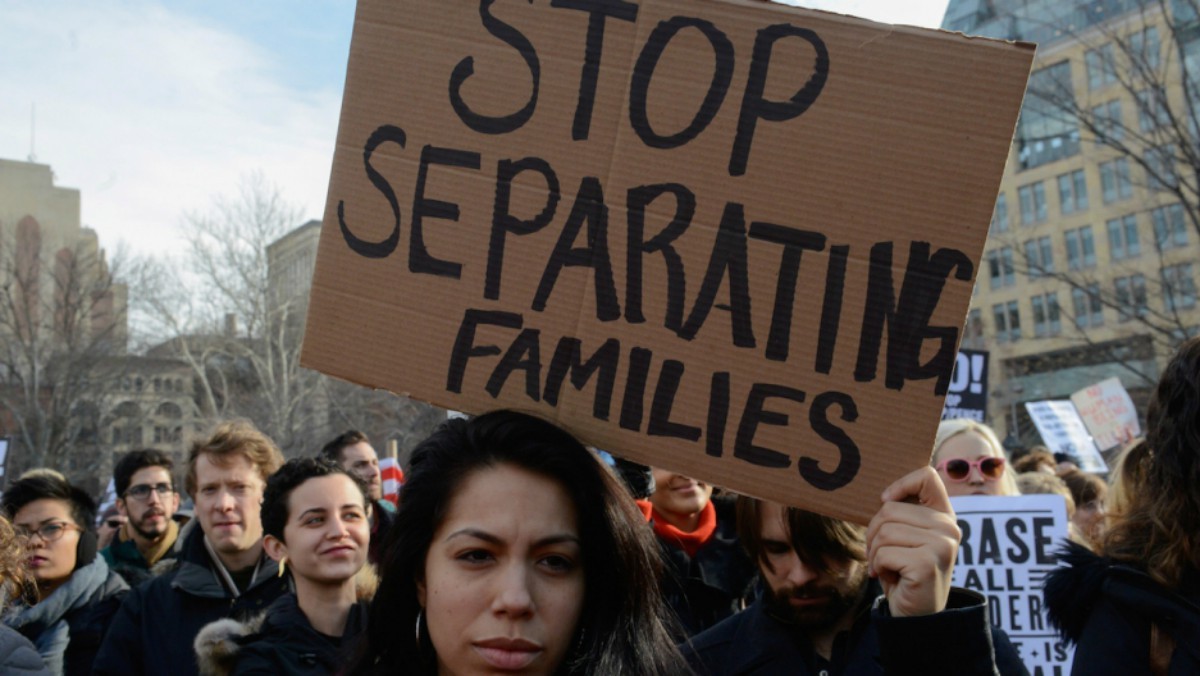Filed under: Analysis, Capitalism, Editorials, Immigration, The State, White Supremacy

The following piece from the Philadelphia anarchist publication Anathema, discusses immigration, ICE, proto-fascism, and the role of the Democratic Party.
On February 8th, Congress passed a budget bill to end the government shutdown that did not include protections for DACA recipients. This budget would not have been possible without Democratic participation — in the Senate, 37 out of 49 Democrats voted for the bill, along with 73 House Democrats. Efforts by Congress in the following week to pass a new bill on immigration failed due to pressure from Trump’s administration. The fate of DACA now lies with the court system.
“Fascism, then, is a way of channeling discontent and hostilities into a consolidation of the status quo when democracy is no longer able to do so.”
Democrats had put up an appearance of resistance to the bill, symbolized by minority leader Nancy Pelosi holding the floor for eight hours to rail against it. Pelosi could have gone all out and used her leverage to whip up Democrats’ no votes, but chose not to. Despite the fact that, according to a Public Policy Polling/Center for American Progress poll, 58% of Americans wanted to include Dreamers as part of the deal to reopen the government, Democratic and Republican lawmakers colluded to ensure that this would not happen.
That means that what looks a lot like a new stage of an ethnic cleansing project by this settler colonial nation-state and its openly white nationalist presidential administration is set to move forward. Hundreds of thousands of people of color in the United States are facing the threat of deportation. In January, the government ended Temporary Protected Status for Salvadoreans, Haitians and Nicaraguans. DACA, which protects 690,000 people, expires on March 5.
Immigration and Customs Enforcement (ICE) removed 226,000 people from the country in the 2017 fiscal year, a slight decrease from Obama’s record last year because of Trump’s enhancements to border security. ICE’s immigration arrests are up by 42%, however. At least 8% of the approximately 110,000 arrests are “collateral arrests,” i.e. other people that the agency finds and kidnaps along the way while arresting an intended target.
ICE has specifically targeted migrants who are leading activist resistance to U.S. immigration policy. In early January, ICE suddenly detained and deported Ravi Ragbir, the executive director of the New Sanctuary Coalition of New York City. This was the second arrest in one week by ICE of a leader in that coalition. Despite New York being a sanctuary city whose Democratic mayor has pledged safety for migrants, the NYPD colluded with ICE to arrest 18 people who attempted to stop the ICE vehicle from carrying away Ragbir.
Though the government has usually tried to excuse deportations by blaming migrants for their “criminal” records and going after low-income people, ICE arrests have now also started to target non-white American residents regardless of how much time they’ve spent in the country, their lack of criminal history, or their class position. In January, ICE kidnapped Syed Ahmed Jamal, a chemistry professor who has lived in the U.S. for 30 years, outside his home, and deported Amer Adi Othman, a Youngstown, Ohio business owner who had lived in the U.S. for nearly 40 years.
Taking measures to limit legal immigration is also now on the table for the first time in many years. This is notable because authorities are only discussing restricting immigration from majority non-white countries, and further indicates that the primary motivation on issues of immigration, on the part of both the Trump administration and his grassroots supporters, is to keep the U.S. a majority-white nation-state.
The U.S. is heightening its borderline-fascist state polices, and Democrats have shown they will go along with anything when the stability of the federal government is at stake. Regardless of individual lawmakers’ reasons for their decisions — the inner workings of which are nearly impossible for lowly plebian commentators like ourselves to know anyway — both political parties now seem willing to toe the line between so-called democracy and fascism in order to deal with the escalating crisis of capitalism and the accompanying threat of mass uprisings.
Because the state’s function is to unify civil society in such a way that preserves the economic system, fascism is not a subversion of capital, but a tendency that, like representative democracy, the state can turn to so as to maintain order. Historically, signs of a crisis in the state’s ability to maintain social cohesion have included an inability by democratic states to impose order after waves of revolts had been snuffed out, continual governmental crises, and imaginary plots against the nation. As with the current U.S. administration, states often respond to such crises by inventing an internal enemy and deflecting domestic conflicts by pursuing militaristic projects abroad.
The current crisis of capital requires a consolidation of force in the hands of the federal government, which either instating a dictatorship or pursuing more modest proto-fascist measures can accomplish. As in Spain, Germany, and Italy in the first half of the last century, economic misery and the rebellions it has produced in the U.S. are currently being channeled into anti-fascism, on one side (which tends to deprive revolutionary tendencies of their original anti-capitalist content) and grassroots fascism that rallies to consolidate the current administration. Meanwhile, Trump’s administration continues to accumulate resources for its police and military forces, fortify its borders, blame migrants and radicals, mysteriously kill off or deport black and brown rebels and activists, and threaten large-scale warfare abroad.
As economic theorist Gilles Dauvé noted in 1998, “An essential aspect of fascism is its birth in the streets, its use of disorder to impose order, its mobilization of the old middle classes crazed by their own decline, and its regeneration, from without, of a state unable to deal with the crisis of capitalism. Fascism was an effort of the bourgeoisie to forcibly tame its own contradictions, to turn working class methods of mobilization to its own advantage, and to deploy all the resources of the modern state, first against an internal enemy, then against an external one” (Endnotes Vol. I, 23-24).
Fascism, then, is a way of channeling discontent and hostilities into a consolidation of the status quo when democracy is no longer able to do so. Fascism, or proto-fascist governance like what we’re currently seeing in the U.S., historically has thrived off of grassroots support that mimics revolution, while drawing anti-capitalist tendencies into a “popular front” approach that gives control back to more liberal agents and institutions and no longer threatens to totally transform the miserable conditions of our lives.
Many radicals and progressives recognize that there’s a rupture in U.S. society and have in response called for rebuilding democratic power — for example, as Bernie Sanders and the Democratic Socialists of America have done. This mass movement strategy should be avoided, as it is another way of rebuilding the social unity that capital needs.
Pursuing false alliances with those who want to defuse hostilities and reform the socioeconomic system will not help us get free. The ruptures and antagonisms within this society are what the state is straining to reconcile because they threaten capitalism — they are serious disadvantages for capital, and thus advantages for us. In the face of the state’s white supremacist maneuvers, we can try various short-term strategies depending on our inclinations — for example, looking out for those who will first be targeted, helping people cross the border, or attacking agencies like ICE and impeding their ability to function. But ultimately it is the borders, and capital along with it, that must go.





